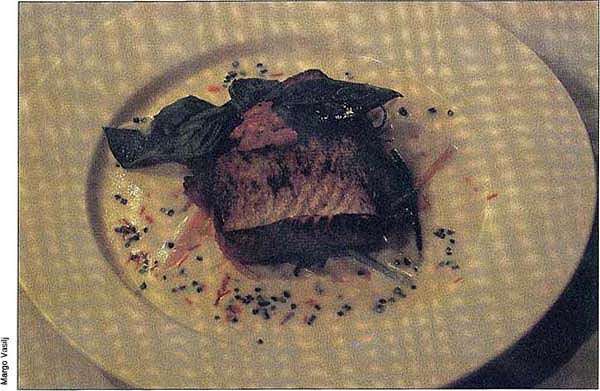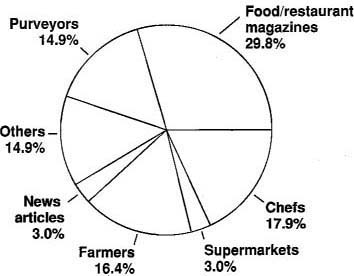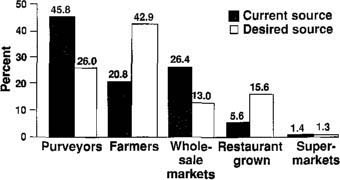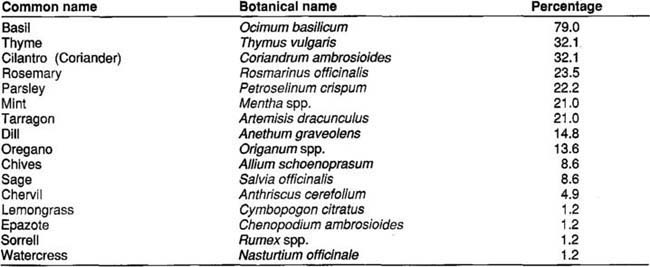All Issues
Culinary herb use in southern California restaurants
Publication Information
California Agriculture 45(1):4-6.
Published January 01, 1991
PDF | Citation | Permissions
Abstract
Southern California restaurants are increasing their use of fresh culinary herbs. Opportunities exist for well-placed growers to take advantage of the restauranteurs' desire to deal directly with farmers.
Full text
Fresh culinary herbs have become an important part of southern California's cuisine. Restauranteurs are interested in enhancing the flavor of foods without increasing the foods' caloric, sugar, salt, and cholesterol contents. Local restaurants have led the way in developing and popularizing the use of fresh herbs. This shift to natural flavor enhancers is in keeping with today's lifestyle of healthier, lighter meals.
Recognizing restauranteurs' special link with trends in food consumption, we conducted this survey to (1) provide farmers with information useful for marketing fresh herbs in the southern California area, (2) assist Farm Advisors and Extension Specialists in making recommendations on herb marketing, and (3) inform the restaurant industry about the extent to which fresh herbs are used in top southern California restaurants.
Sampling methods
For this survey, we selected 500 of southern Californias' “outstanding” restaurants as listed in a 1989 publication of top restaurants in the Los Angeles area. Restaurants were located as far south as San Diego, as far east as Palm Springs, and as far north as Santa Barbara. In the summer of 1989, we mailed a questionnaire to the chef or manager of each surveyed restaurant, asking that it be returned within two weeks. Out of a mailing of 500,87 surveys were returned and analyzed.
Of the returns, 75 were from restaurants in Los Angeles County, 9 each from Orange and San Diego counties, and 6 from Santa Barbara County. Respondents could identify their restaurants as either American, Asian, Californian, Continental/International, French, or Mediterranean.
Changes in fresh herb use
Most chefs and restaurant managers (29.8) said they learn of new fresh herbs through food and restaurant magazines (fig. 1). Communication among chefs and contact with farmers ranked second (17.9) and third (16.4), respectively, as avenues to new culinary herb use. Purveyors ranked fourth (14.9) as a source for information on new herbs for the restaurant industry. Since purveyors play the leading role in supplying fresh herbs to top California restaurants, they may be able to stimulate the usage of particular herbs through a better collective use of the media or increased appeals to restauranteurs.
Fig. 1. Where the chefs of surveyed southern California restaurants learn of the use of different culinary herbs.
Other avenues for the introduction of fresh herbs include the popular press (3.0), and supermarkets (3.0). Respondents also listed garden magazines, food shows, and television.
Reason for usage
The vast majority of respondents (96.5) use fresh herbs in food preparation or presentation. When asked to select all applicable reasons from a list, an overwhelming majority of respondents (93.9) indicated they use fresh herbs for the added flavor. Many also use herbs for the aroma (74.1), and almost as many (68.3) use fresh herbs for garnishing. A minority (27.1 ) use herbs for customer education, and fewer still (20.7) use culinary herbs for health benefit.
Sources of fresh herbs
Many of the responding restaurants (45.8) receive the bulk of their fresh herbs from local purveyors (fig. 2). Wholesale markets supply 26.4 of the restaurants with most of their fresh herbs, and farmers deliver most the fresh herbs to a fifth of the restaurants. A few restaurants (5.6) grow most of their fresh herbs themselves,- and only 1.4 of respondents purchase most of their fresh herbs from local supermarkets.
When asked from which source they would prefer to obtain most of their fresh herbs, most restaurants chose decisively in favor of the farmer (42.9), while 26.0 prefer to continue to work through a purveyor. This is in direct contrast to the current market situation, where restaurant purveyors dominate the distribution of fresh herbs. Marketing opportunities therefore appear to exist for local farmers willing to supply fresh herbs directly to restaurants.
A minority of restaurants (15.6) would like to attempt to grow most of their fresh herbs. Another 13.0 prefer to continue purchasing from the downtown produce market, and 1.3 would continue using supermarkets as a major source.
Growing conditions are considered by some respondents to be important in selecting fresh herbs. For aroma and flavor, 56.2; prefer field grown herbs, 3.8 prefer hothouse (greenhouse) grown herbs, and 40.0 see no difference. Respondents split about evenly on organically grown herbs: 44.4 prefer organically grown herbs, but 45.7) see no difference between organic and non-organic production.
Most commonly used herbs
The number-one fresh herb, selected most often as one of the three most commonly used herbs, is sweet basil, as indicated by 79.0 of respondents over all restaurant types. Thyme and cilantro are tied for second, with 32.1 each. Table 1 ranks the herbs most commonly used by surveyed southern California restaurants.
Basil is also the most commonly used herb for each restaurant type. It ranks among the top three herbs for 93.3 of California style restaurants, 92.3 of Mediterranean restaurants, 80.0 of Asian restaurants, 84.2 of French restaurants, and 70.0 of both American and Continental/International restaurants (table 2).
Fig. 2. Southern California restauranteurs' current and desired sources for purchase of culinary herbs.
The second most popularly used herb varied with type of restaurant. Mint was tied with basil for first place in Asian restaurants (80) and placed second (50.0) in American-style restaurants. Rosemary placed second in Mediterranean restaurants(76.9). Other second-place finishers included cilantro (60.0 of Continental/International restaurants) and thyme (53.3 of Californian-style restaurants and 50.0 of American-style restaurants, where it is tied with the use of mint).
Amount used
Results of the survey indicate that 39 of restauranteurs increased their use of fresh herbs over the preceding year. Sixty-one percent of chefs and restaurant managers indicated that fresh herb consumption had remained the same when compared to the previous year. No one reported a decrease in fresh herb use. The median restaurant consumption of fresh herbs is 10 pounds a week. Restauranteurs spend more to purchase fresh herbs in winter than in summer, and purchase slightly smaller amounts in winter. For all restaurants, the median weekly expenditure was $80.00 in summer and $87.00 in winter.
Asian restaurants' median weekly purchase (3.8lb. and $37.50/week, both summer and winter) is less than for all other restaurant types. Mediterranean restaurants' expenditure on fresh herbs exceeds that of all other restaurant types ($200.00/week, summer and winter). Mediterranean restaurants purchase a median quantity of 11 lb/week year-round.
French restaurants' median expenditure on fresh herbs was $100.00/week in the summer and $105.00/week in the winter. Annual median use was estimated at 9.0 lb/ week. American-style restaurants' median winter expenditures on fresh herbs ($87.50) falls below summer expenditures ($100.00). Continental/International and California-style restaurants also reported a dip in winter expenditures. The shortage of fresh herbs in the winter resulting from unfavorable growing conditions is the probable cause of reduced expenditures for these restaurants.
Farmers growing herbs for the restaurant trade may be interested to know that Asian restaurants appear to require fewer varieties (five herbs) and fewer pounds (3.8 lb/week) than other restaurant types. A grower's average weekly income for sales to an Asian restaurant may not exceed $37.50. This may result partly from the extensive use of dried herbs and spices in many Asian dishes. French restaurants use the greatest variety of herbs (13 herbs), followed by California-style restaurants (11 herbs). Results of the survey indicate that as many as ten varieties of herbs are commonly used in Mediterranean and American-style cuisines.
When growing herbs for a particular type of restaurant, a grower should consider the many herb varieties used by the restaurants as well as the restaurants' average weekly expenditures for these herbs. When asked if they would be willing to spend more for fresh herbs, 56.4 of respondents said they would, provided that quality, quantity, and varietal selections improved.
Finally, the vast majority (90.4) of responding chefs and restaurant managers believed that herb usage would continue to grow. A minority (8.4) thought herb usage had leveled off, and fewer still (1.2) thought it was a passing fad.
Limitations on use
Most respondents (64.8) indicated that there are no significant limitations on their use of fresh herbs. Those who indicated that there are limitations on their use of fresh herbs were asked to rank the limiting factors from 1 to 10, using a list of 10 suggested limitations. High cost was cited most often (63.6). Short storage life ranked second (50.0). Poor quality was considered to be a limiting factor by 36.4 of respondents.
The unavailability of some herbs was ranked by 31.8 of respondents as limiting their use of fresh herbs. Chervil was listed by 5.9 of all respondents as the least available herb. Basil, epazote and lavender all tied for second place as the herbs that restauranteurs have the most trouble finding. Other herbs that were difficult to find included opal basil, mint sorrell, tarragon, and thyme. Lavender, one of the hardest-to-find herbs, was not listed among the 16 herbs most commonly used by southern California's restauranteurs.
The hardest herbs to find are not necessarily the ones most sought by restauranteurs. Chervil, used by 4.9 of respondents (table 1), was reported hard-to-obtain by 5.9 of respondents. This might indicate that all or part of the 4.9 still had trouble locating sufficient quantities of chervil, or that an additional 5.9 of respondents would use chervil if it were available to them. In either case, the percentage of chefs using chervil would probably not exceed 10.0.
Conclusions
Southern California's top restaurants routinely incorporate fresh herbs into their menus, and fresh herb usage will probably continue to grow. Restauranteurs would like to get fresh herbs directly from local growers. These results should encourage farmers wanting to make direct sales to local restaurants.
No one is working in an organized way to keep restauranteurs informed on the usage and availability of new and established varieties of fresh herbs. An organized marketing effort by growers and purveyors might help increase the quantity of fresh herbs used by restaurants, and subsequently by consumers.
High cost was the factor most often cited as limiting the increased sales of herbs. However, most restauranteurs indicated their willingness to pay more for fresh herbs, provided there was a corresponding improvement in quality, quantity, and varietal selection.
While most surveyed restaurants use basil extensively, growers should tailor their varietal production to suit specific cuisines or chefs. A grower may profit more, for instance, by selling directly to Mediterranean restaurants, and may be requested to grow a greater variety of fresh herbs by French restaurants.









